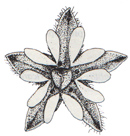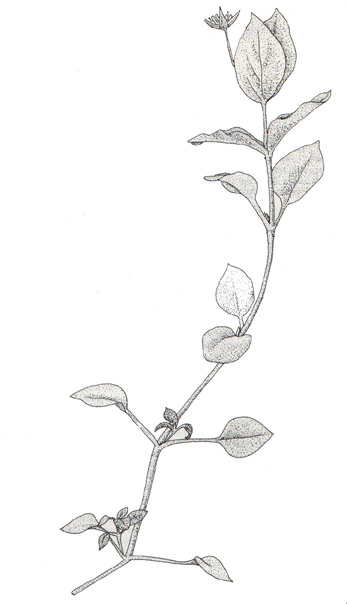
Chickweed blossom

 Chickweed blossom |
 |
Chickweed
Stellaria media
(Caryophyllaceae)
Description:
Chickweed stems, usually less than 1 foot (30 cm.) tall,
are so weak that the whole plant leans on other plants or adjacent firm supporting
surfaces, often forming a tangled mass. Wherever the stem touches the ground
the nodes give rise to roots and new stems. The stem has a row of hairs that
change sides at the nodes.
The opposite leaves are ovate to oblong in shape. The higher leaves are largely sessile, while those lower down on the stem have hairy petioles. The flowers, about 1/s inch (2 to 3 mm.) in diameter, consist of five petals, but each petal is so deeply cleft that the blossoms look ten-pointed. The white petals are shorter than the green sepals.
Distribution:
Occurs worldwide. Very common around dwellings.
Constituents:
The main components are potash salts and vitamin C.
Medicinal uses:
The action of chickweed is demulcent, refrigerant, and
antiscorbutic. Chickweed, called the magic healer by Gibbons, is my favorite
herb to "draw the poison out" of infections, inflammations, boils, or abcesses.
Any form of internal inflammation is soothed and healed by application of chickweed
as an external poultice.
Fresh chickweed leaves are so soft and tender that it is possible to macerate them with your thumbnail into a green pulp. Apply this pulp fresh every hour or so and hold it in place with a bandage. Some herbalists prefer to cover the fresh herb with boiling water, cool it a bit, and then apply.
Chickweed is also used for burns, skin diseases, sore eyes, and wounds.
(Leek) A salve of chickweed powder may be applied in addition to bathing with chickweed tea and drinking the tea.
One old astrological herbalist says of chickweed, "It is a fine, soft, pleasing herb, under the dominion of the Moon. In a word it comforteth, digesteth, defendeth, and supporateth very notably."
A vaginal bolus formula from Christopher that I have modified and used includes chickweed along with squaw vine herb, slippery elm bark, comfrey root, yellow dock root, golden seal root, mullein, and marshmallow root, with cocoa butter to hold them all together. Wrap with gauze to form a tampon and replace three times a day.
Culinary use:
Chickweed is fine to eat raw or cooked.
Copyright © 1987 by Eleanor G. Viereck